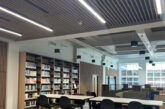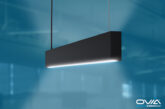
Mike Collins, head of Ovia lighting, takes a look at the drive towards Net Zero and how smart lighting has a vital role to play in building automation and energy efficiency.
The Paris Agreement is a legally binding international treaty on climate change, adopted by 196 parties at COP 21 in Paris, on 12 December 2015 and entered into force on 4 November 2016. Its goal is to limit global warming to well below 2, preferably to 1.5 degrees Celsius, compared to pre-industrial levels.
The Paris Agreement is a landmark in the multilateral climate change process because, for the first time, a binding agreement brings all nations into a common cause to undertake ambitious efforts to combat climate change and adapt to its effects. To achieve this long-term temperature goal, countries aim to reach global peaking of greenhouse gas emissions as soon as possible to achieve a climate neutral world by mid-century. Put simply, net zero is the balance between the greenhouse gases produced and the amount taken away.
Whilst it might not garner as many headlines as clean energy innovations, energy efficiency plays an essential role in achieving net zero. According to the World Green Building Council (WorldGBC), if well-known energy efficiency best practices were implemented on a large scale, building energy demand could be reduced by one-third by 2050 globally, delivering 5.8 billion tons of CO2 emissions savings
The role of LED lighting in net zero targets
According to The Climate Group: “LED lighting has been recognised as one of the most actionable and ready-to-implement technologies for cities to transition to a low carbon economy and peak emissions in the next decade.” It also states that lighting accounts for nearly 6% of global CO2 emissions, and a global switch to LEDs could save over 1,400 million tons of CO2 and avoid the construction of 1,250 power stations.
Switching to LEDs is an easy win – something as minor as a 20% reduction in energy costs can add the same benefit as a 5% increase in sales for business. Upgrading from conventional lighting to LED technology can deliver significant cost savings of up to 80% for a business. This is according to the Government Department for Business, Energy and Industrial Strategy. By replacing incandescent lamps with LED lamps there is the potential to reduce electricity consumption by 50% to 80%. If you add in controls and IoT devices like motion sensors, building owners will be able to further manage lighting use and electricity consumption.
Smart controls
The use of appropriate lighting controls can further boost savings. These can include daylight linked photoelectric control, presence detection with occupancy sensors, time switching and flexible manual control. According to BEIS savings of 30%-50% are common for circumstances where automatic controls are used.
Control is the key word with smart lighting because it empowers building owners and facilities managers to ensure optimal energy usage with the least waste. The occupants of a building will often not be aware of the waste, or they do not take responsibility for taking any action and this makes the need for a degree of automatic lighting control more important.
Smart lighting uses artificial intelligence and machine learning, all powered by data fed via connected Internet of Things devices sited around a building. Such devices may include the likes of sensors that detect room occupancy, time of day and volume of natural light. One of the most common approaches to automatic lighting control is the use of occupation detection. Passive infra-red occupancy detectors are commonly used for detecting the movement of people within their detection zone. Microwave sensors are also used in a range of settings.
Lots of detection products include photocell (light level) detection, which provides these lighting controls with the ability to control lighting loads based on whether an area is occupied as well as the prevailing ambient lighting conditions. There are controls which are simply designed to switch on or off, and others that will also dim or brighten dimmable lighting loads in response to changes in daylight. DALI and 0-10V are common examples of dimming technologies. Sensor technology has the added advantage of being touch-free which is an important consideration as we strive to maintain a clean environment and create safer spaces for everyone.
Health and well-being
When looking to deliver low carbon, high efficiency lighting solutions, consideration should be given to the needs of the people who occupy the building spaces. Staff represent approximately 90% of the running costs of a business, so their health and well-being is a major consideration, and the health and well-being of people doesn’t have to come at the cost of carbon emissions. Delivering a high quality lighting design that follows industry guidance, will result in resilient, adaptable spaces that puts people first. This will ensure the long-term viability of the solutions and minimise the long-term environmental effects.
Find out more about Ovia here









